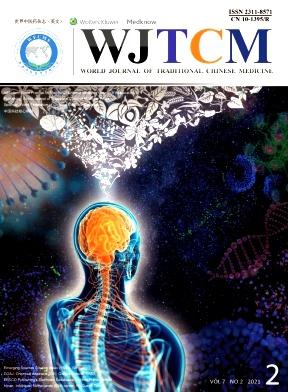Isobaric tag for relative and absolute quantitation-based proteomics for investigating the effect of Guasha on lumbar disc herniation in rats
IF 3.2
3区 医学
Q1 INTEGRATIVE & COMPLEMENTARY MEDICINE
引用次数: 0
Abstract
Objective: The objective of the study is to examine the possible mechanism by which Guasha (scraping therapy) affects the expression profiles of proteins in a lumbar disc herniation (LDH) rat model using isobaric tags for relative and absolute quantitation (iTRAQ)-based proteomics. Methods: Thirty-six rats were used in this study. LDH rats were subjected to noncompressive LDH surgeries. Rats were randomly divided into the model and Guasha groups. Guasha was applied on alternate days for a total of nine times (three courses). At the end of each course, six rats were randomly selected from each group and their blood samples were collected. iTRAQ labeling was used to examine the mechanism of action of Guasha against LDH. The molecular functions, cellular components, and biological processes were analyzed using gene ontology analysis. The Ingenuity Pathway Analysis database was used to identify canonical pathways involving these proteins. Results: Compared to the model group, 198, 182, and 170 proteins were identified as differentially expressed at the three respective Guasha treatment courses. Pathways, including focal adhesion kinase signaling, acute-phase response signaling, and the LXR/RXR activation pathway, were closely related to the effects of Guasha in LDH rats. Furthermore, Rac1, Orm1, and Hpx were validated by western blotting, and the results were consistent with the protein expression levels observed using the iTRAQ method. Conclusion: Guasha could not only regulate the pathological changes related to LDH, but also achieve therapeutic effects by stimulating physiological changes. Our results offer a better understanding of the effects of Guasha on LDH.等压标签的相对和绝对定量蛋白质组学研究瓜沙对大鼠腰椎间盘突出症的影响
目的:本研究的目的是利用等压标签相对和绝对定量(iTRAQ)为基础的蛋白质组学,研究刮痧疗法影响腰椎间盘突出症(LDH)大鼠模型中蛋白质表达谱的可能机制。方法:选用大鼠36只。LDH大鼠进行非压缩LDH手术。将大鼠随机分为模型组和瓜沙组。瓜沙隔日应用,共9次(3个疗程)。每个疗程结束时,从每组中随机抽取6只大鼠,采集其血液样本。采用iTRAQ标记法研究瓜沙抗LDH的作用机制。利用基因本体分析对其分子功能、细胞成分和生物过程进行分析。独创性途径分析数据库被用来识别涉及这些蛋白质的典型途径。结果:与模型组比较,瓜沙给药三个疗程分别有198、182和170个蛋白表达差异。瓜沙对LDH大鼠的作用与局灶黏附激酶信号通路、急性期反应信号通路、LXR/RXR激活通路密切相关。western blotting验证了Rac1、Orm1、Hpx的表达水平,结果与iTRAQ法观察到的蛋白表达水平一致。结论:瓜沙不仅能调节LDH相关病理变化,还能通过刺激生理变化达到治疗效果。我们的结果为瓜沙对LDH的影响提供了更好的理解。
本文章由计算机程序翻译,如有差异,请以英文原文为准。
求助全文
约1分钟内获得全文
求助全文
来源期刊

World Journal of Traditional Chinese Medicine
Medicine-Complementary and Alternative Medicine
CiteScore
5.40
自引率
2.30%
发文量
259
审稿时长
24 weeks
 求助内容:
求助内容: 应助结果提醒方式:
应助结果提醒方式:


